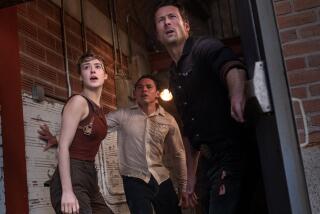‘WONDERWORKS’ DRAMA : RODIA, WATTS TOWERS HAVE RENEWED LIFE
- Share via
Sam Rodia, the Italian immigrant who spent 33 years single-handedly crafting the Watts Towers, disappeared in 1954, a year before a fire destroyed his home beside the graceful spires.
It turned out that Rodia (who sometimes was also called Simon Rodia) had been living alone in a rooming house in Northern California and later in a convalescent hospital, but he died in 1965 without ever returning to the towers.
In the years since, the 100-foot-tall steeple forest, aglitter with colorful bits of broken pop bottles and tea cups, 72,000 seashells and detritus, has gained international fame but has remained encased in scaffolding and been mostly off limits to the public.
In recent weeks, however, a television company has breathed renewed, make-believe life into the Watts Towers.
“Wonderworks,” the Emmy Award-winning PBS family series, took over the towers for three weeks to film a story about Rodia called “Daniel and the Towers.” Judith James, who has produced a television movie about teens and a KCET program about Eleanor Roosevelt, produced the new drama that tells of Rodia and a delinquent neighborhood boy who learns a new set of values from the pair’s unlikely friendship.
“Daniel and the Towers,” which is scheduled to air next May, is part fact, part fantasy. Allan Arbus portrays Rodia, and Miguel Alamo plays the 12-year-old Daniel. The script, written by Camille Thomasson, was based partly on Anton Kline’s UCLA doctoral thesis, partly on research, and partly on imagination. “It was a writer’s nightmare and a writer’s dream,” James said during filming at the Towers.
“We found out that Rodia was a cantankerous guy. There are stories that though he talked to some neighbors, he screamed and yelled at people. I got interested in what kind of little kid would get into the company of such a man and get under his skin.”
In the TV story, the pair come together after Daniel, who’d been using Rodia’s cache of ceramic pots and glass bottles for target practice, agrees to collect more junk for Rodia, who, in exchange, repairs a neighbor’s window the boy has broken.
“Something about this tough little kid appeals to Sam,” James said of the “Wonderworks” story, “and Rodia ends up kind of cocking his head and deciding to give the kid a chance. Daniel learns from Sam the difference between good and bad junk, metaphorically and literally, and in the course of this, understands several things . . . like, (when Daniel complains about the downtrodden Watts neighborhood), Rodia says, ‘Nowhere is somewhere if you make it somewhere, and somewhere is nowhere if you make it nowhere.’
“That’s the whole sense of this story--look at what this man did with other people’s quote, unquote, junk .”
The story is also about Rodia’s indomitable spirit, James said. The unlettered man, who at times worked as a tile setter, built the towers without scaffolds, cranes, hired hands--or much emotional support, she said.
At one point, there was a plan to call the show “Ask Columbus.”
“Rodia was mesmerized by Christopher Columbus and at times he told stories about his towers representing the Nina, the Pinta and the Santa Maria,” James said.
And, just as people doubted Columbus, “everyone said Sam couldn’t build the towers. So our theme was about pitting yourself against something and doing it, and every time someone tells Daniel he can’t do something, we have Sam saying, ‘You can do it!’ ”
However, the “Ask Columbus” title was eventually dropped in favor of “Daniel and the Towers” in order “to convey the program’s theme more clearly and make a more direct reference to the story’s unique setting, the Watts Towers,” James explained.
Prior to the filming, the crew partially rebuilt Rodia’s house, but the set was dismantled after the three weeks’ work was completed. Only about six-square-feet of the humble abode, built within a few feet of the towers beside a railroad track, were left after the 1955 fire, James said.
Taper Media Enterprises, which produced the show, made a $1,500 voluntary contribution to the Watts Towers Arts Center in appreciation of being allowed to film at the towers. They were not required to pay the city, which operates the towers, to work there.
“Our set designer, John Gillis, working from photos, put in these stained glass windows and doors,” James said as she walked around the edifice.
The TV crew also carefully covered parts of decorated walls surrounding the towers so that Arbus and Alamo could press new shells and glass bits into wet cement.
“We went to swap meets and got the oldest 7-UP bottles we could find, and we went to old tile factories and found tiles from the ‘30s and ‘40s” to construct the set,” James said.
“You can sit here and see the environment Rodia made for himself. It’s been a magical part of this project.”
More to Read
The complete guide to home viewing
Get Screen Gab for everything about the TV shows and streaming movies everyone’s talking about.
You may occasionally receive promotional content from the Los Angeles Times.






